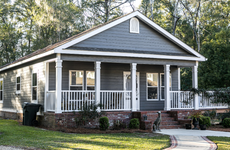Mortgage rate forecast for December 2022: A celebratory pause?

The Bankrate promise
At Bankrate we strive to help you make smarter financial decisions. While we adhere to strict , this post may contain references to products from our partners. Here's an explanation for .
Welcome to December, the height of holiday shopping season — except for home shopping, that is.
Historically, many homebuyers put their plans on hold until January, and with affordability diminished by higher mortgage rates, that might be the case even more so this year.
Then again, if rates pull back, as they did last month, some buyers might get back in the market. Should house-hopeful buyers lock in a rate any time soon? We turned to the pros for answers.
December mortgage rate predictions
Barring an unexpected economic shock — or a more aggressive-than-anticipated move by the Federal Reserve mid-month — mortgage rate watchers anticipate rates to stay consistent. Rates have fallen some on the news that one measure of inflation, the Consumer Price Index, came in at a smaller 7.7 percent in October.
“It will take more evidence of easing inflation pressures, but the 30-year fixed will be around the 6.5 percent mark and the 15-year fixed around the 5.8 percent mark in December,” says Greg McBride, chief financial analyst for Bankrate. “If investors believe inflation has peaked, that opens the door to a decline in mortgage rates.
“Bond yields and mortgage rates have pulled back notably since the release of two main inflation reports — the Consumer Price Index and the Producer Price Index — showed better-than-expected or less-bad-than-expected results,” says McBride.
If investors believe inflation has peaked, that opens the door to a decline in mortgage rates.
— Greg McBrideChief financial analyst, Bankrate
While the Fed has some impact on mortgage rates, specifically variable-rate products, fixed mortgage rates are primarily influenced by the 10-year U.S. Treasury yield. The spread between the two has widened, but the yield has also dropped recently.
“Consequently, I see some moderation in mortgage rates by the end of the year,” says Clifford Rossi, a professor at the Robert H. Smith School of Business with the University of Maryland, who for December expects the 30-year rate to average 6.8 percent to 7 percent and the 15-year rate to average 6.1 percent to 6.3 percent.
“Unless inflation surprises to the upside and the Fed feels it needs to continue to aggressively hike rates, we may be at or near a cyclical peak for mortgage rates and see them plateau or even begin to tick down over the course of 2023,” says Rick Sharga, executive vice president of Market Intelligence for ATTOM.
Sharga forecasts the 30-year rate to hover between 6.5 percent and 7 percent, and the 15-year rate between 6 percent and 6.5 percent.
“Mortgage rates are likely to stay below 7 percent in December, hovering around 6.7 percent on average, provided there are no surprises in the upcoming inflation report,” says Selma Hepp, deputy chief economist for CoreLogic.
Will mortgage rates rise in 2023?
This year has been one of the most challenging in which to forecast mortgage rates thanks to unprecedented volatility from multiple forces, including the pandemic’s aftereffects, the war in Ukraine and severe weather.
“We’ve never seen rates double in so short a period, and the recent drop in rates was among the largest in decades,” says Sharga. “The spread between yields on the 10-year U.S. Treasury and rates on a 30-year mortgage — normally a reliable predictor — have been unusually wide as well. The Fed has more aggressively and more rapidly increased the fed funds rate than at any time in the last 40 years, roiling the financial markets in accomplishing one of its goals: to slow down what was an overheated real estate market.”
Indeed, home prices began to moderate in the back half of this year, with the latest S&P CoreLogic Case-Shiller index again dropping, this time to 10.6 percent in September, down from 12.9 percent in August.
While it was difficult to predict the trajectory of rates this year, there are some signs homebuyers might soon get a break as the Federal Reserve tees up a less-aggressive policy.
“Data show that the higher federal funds rates are starting to cool off inflation,” says Nadia Evangelou, senior economist and director of Real Estate Research for the National Association of Realtors. “Thus, the Federal Reserve will likely downshift to smaller rate hikes in the following months. This could help or get rates to remain below the 7 percent threshold at the beginning of the year.”
A recession in 2023, however, could switch things up again, especially if the job market suffers.
“If inflation remains well above 6 percent or 7 percent in the first quarter of 2023, I could see additional smaller rate hikes in the 25- to 50-basis point range, assuming the labor market holds up,” says Rossi. “A noticeable rise in the unemployment rate could, however, make the Fed think twice about even modest rate hikes early next year…and a wildcard that could severely affect the supply chain and add to inflationary pressures is a potential rail strike. If that were to occur, I could see mortgage rates loitering around the 7 percent level for some time.”
Your next moves
If you’re in a solid financial position to buy a home, now isn’t necessarily a bad time to make a purchase, despite some headlines to the contrary. It depends on many variables, including your risk tolerance and timeline.
“Given that competition for homes has waned notably since the spring, this would be an opportune time for potential buyers who are financially ready and stable to buy a home,” says Hepp.
“There is typically less competition from other buyers and investors right now, home prices in most of the country are either rising much more slowly or are falling slightly and sellers tend to be more willing to negotiate at this time of year,” says Sharga. “It’s also likely mortgage rates will fall over the next year or two, which may allow you to refinance and lower your monthly payments.”
If the rates on fixed mortgages are too much for you right now, however, consider an adjustable-rate mortgage (ARM).
“If you’re making a down payment of 15 percent or more and don’t plan to be in the home for more than 10 years, an adjustable-rate mortgage could be a risk worth taking,” says McBride. “As long as your timetable pans out, it functions as a fixed-rate mortgage but at a rate that is 0.5 percent to 1 percent below that of a fixed-rate mortgage.”
Keep in mind, the rates on ARMs reset at predetermined intervals — as soon as six months — “and in a rising rate environment, it may not be the right product for some borrowers, particularly if you plan on being in the home for a long time,” says Rossi.
You’ll also need to qualify for the higher reset rate, even if you can easily afford the initial rate.
On the other hand, if you’re hoping to refinance to get cash so you can remodel your home instead of move, you might want to wait things out.
“It doesn’t make sense to refinance a 3 percent rate at 6.5 percent just to get some additional cash,” says McBride. “If your mortgage is completely paid off or has a very small balance, then a cash-out refinance may be your best route to tap your equity. Otherwise, look into a fixed-rate home equity loan or a HELOC that offers an introductory promotional rate to buy you some time before the higher variable rate kicks in.”
Related Articles




Mortgage rate forecast for January 2022: Higher rates ring in the New Year